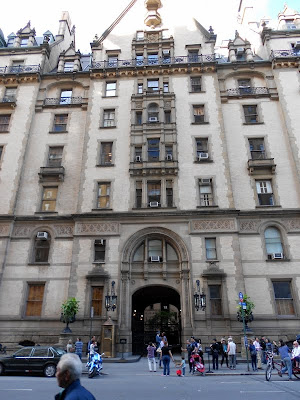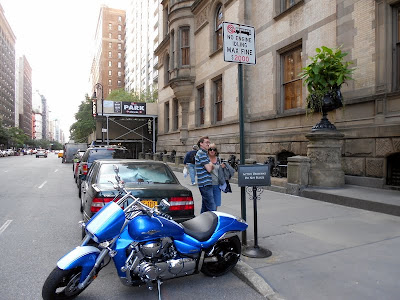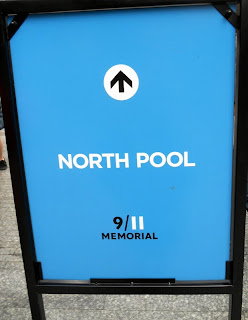We were booked into Ground Zero for 11 am so we set off walking straight after breakfast. As with last night, the architecture along the way was stunning.
The walk took us through City Hall Park, a communal pasture in the 17th century and the seat of New York's municipal government since 1812.
Towards the northern end of the park sits City Hall, a gleaming white marble palace virtually unchanged since it was completed in 1812. It's the oldest city hall in the US to retain its original government function.
The Woolworth Building
From 1913 to 1929 this was the tallest building in the world.
Covered in white terracotta and fringed with Gothic-style gargoyles and decorations, this 'Cathedral of Commerce' oozes money and prestige. Frank Woolworth made his fortune from his 'five and dime' stores (everything cost either 5 or 10 cents, and strictly no credit) and true to character, he paid cash for the construction of his skyscraper. Reliefs at each corner of the the ornate lobby show him counting out the purchase price in nickels and dimes!
GROUND ZERO
'Where you were on 9/11' has become one of those iconic milestones in life, on a par with 'where you were when Kennedy was shot'.
A total of 7 buildings were destroyed in the attack and today the area is coming to the end of a massive rebuilding and regenerating project.
The South Pool
The 2 memorial pools represent the footprints of the original towers, each one about one acre in size.
The names of the 9/11 victims are inscribed on parapets surrounding the pools.
The racial diversity of the victims is all too apparent from their names. You can't but be moved by the sheer scale of the death toll and the occasional rose placed by a particular name. We were particularly struck by a man lovingly making a brass-rubbing of a name and showing it to his toddler son, and the reference to a woman 'and her unborn child' who died.
Waterfalls tumble down the 30 feet sides of each pool, seeming to disappear into the abyss.
All around you can see evidence of regeneration, but mixed with the iconic buildings of an earlier pre-terror days.
It's a truly beautiful memorial full of trees and seating areas where you can quietly sit and think; full of people but with no feeling of being rushed or pressurised.
On a much lighter note, we headed for Starbucks and who should Sue spot walking along with his wife, clearly having been to the memorial too? Fabio Capello, ex-England football manager. New York gave him near-anonymity.
Battery Park City
The hole dug for the foundations of the former World Trade Centre threw up a million cubic tons of earth and rock which was then dumped into the Hudson river to form the 23 acre base of Battery Park City, a development of office-blocks, apartments, shops and a landscaped esplanade.
THE IRISH HUNGER MEMORIAL
Sue was keen to visit this sobering monument to the more than one million Irish people that starved to death during the Great Famine of 1845-1852. The Famine sparked a flood of Irish immigrants to the US, mostly through New York. Many of these came from County Longford.
An authentic famine-era stone cottage , one of the many abandoned in the west of Ireland, was transported from County Mayo by artist Brian Tolle and set on a raised embankment overlooking the water.
We followed the meandering path through the grassy garden (the grass and flowers were all brought from Ireland) and stones 25 feet to the top.
32 stones commemorate the counties of Ireland.
They're in no particular order, and half-way up the path we found the Longford stone.
Poet and newspaper editor William Cullen Bryant is credited with first publicizing the idea for an open public space in Manhattan in 1844. In 1851 City Hall agreed, paying $5 million for 840 acres north of the (then) city limits at 38th Street. It took 16 years and $14 million ($270 million in today's money) to construct the entire park, opening to the public in 1876.
Today it serves purposes as varied as the individuals who take advantage of it: an environmental haven, a beach, a running track, a venue for pop music and street entertainers, and much more: most of which we saw on the sunny Sunday afternoon we were there.
 |
| The Reservoir |
 |
| The Mall |
| Click to enjoy! |
 |
| Sheep grazed here till 1934. |
 |
| A peaceful area dedicated to John Lennon |
 |
| An Italianate mosaic donated by Yoko Ono |
John Lennon was murdered on December 8th 1980 by Mark Chapman in front of his home in the Dakota Building.
 |
| THE DAKOTA BUILDING |
 |
| Just to prove we were there! |
 |
| The San Remo |
Not an area of the city we'd yet visited and redolent of Bob Dylan, we decided to give it a try for dinner tonight. After consulting the books we opted for the much-recommended Ye Waverly Inn.
Walking through Greenwich Village lived up to expectations, and the restaurant building, partly dating from the 17th century, was quaint and quirky.
BUT the wine menu had to be seen to be believed. Prices for a bottle ranged from $60 to $1760 (yes, you have read that correctly, one thousand seven hundred and sixty dollars), with the average price around $400!!! We were cheapskate and ordered 3 beers at $8 each, obviously much to the waiters'
disgust.





























1 comment:
Amazing photos.
So many buildings and sights for see. the Architecture is a little like Melbourne but obviously that is smaller. (probably built around the same era by similar people and added to over the years at approx the same times?? Mum you might know more?)
Ground Zero looks very moving and so does the Irish memorial. I can only imagine.
Post a Comment